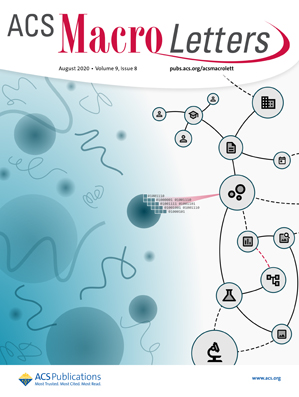氢原子转移、可逆加成-破碎链转移聚合和五氟苯基酯-连接化学相结合的商品聚合物功能化研究。
IF 5.1
Q1 POLYMER SCIENCE
引用次数: 0
摘要
由于碳氢键在各种商品聚合物中普遍存在,以及对商品聚合物升级循环的强烈愿望,开发直接由碳氢键功能化商品聚合物的高效通用策略引起了人们越来越多的兴趣。然而,C-H的活化效率通常很低(<20%),并且每个活化的C-H键只引入一个(潜在的)功能单元。引入的功能单元的低含量可能是一个很大的障碍,以提高所得聚合物的性能。本文报道了一种光催化氢原子转移可逆加成-断裂链转移(HAT-RAFT)接枝聚合策略,利用商品聚合物的C-H键作为引发位点,将活化的五氟苯基酯(pfe)的聚合物侧链引入聚乙二醇、聚环氧丙烷、聚丁烯、聚丙烯和聚乙烯吡啶酮等商品聚合物中。接枝聚合的五氟苯基丙烯酸酯(PFA)具有活性/可控特征和时间可控性。在接枝聚合的放大作用下,每个活化的C-H键可以引入数十个PFE,导致PFE基团的含量很高。由于pfe在温和条件下对含氨基和含羟基分子具有较高的反应活性,具有优异的效率和基团耐受性,引入PPFA链的pfe可以通过pfe连接化学进行定量酯交换和酰胺化,从而实现商品聚合物的高效功能化。本文章由计算机程序翻译,如有差异,请以英文原文为准。
Commodity Polymer Functionalization by a Combination of Hydrogen Atom Transfer Reversible Addition-Fragmentation Chain Transfer Polymerization and Pentafluorophenyl-Ester-Ligation Chemistry.
Development of highly efficient and versatile strategies for functionalization of commodity polymers direct from carbon-hydrogen (C-H) bonds has attracted growing interest due to the ubiquity of C-H bonds in various commodity polymers and the great desire for upcycle of commodity polymers. However, the efficiency of C-H activation is usually low (<20%) and only one (potential) functional unit was introduced into each activated C-H bond. The low content of introduced functional units could be one great hindrance to the improvement of performance of resulting polymers. Herein we report a photocatalytic hydrogen atom transfer reversible addition-fragmentation chain transfer (HAT-RAFT) grafting polymerization strategy to introduce polymeric side chains of activated pentafluorophenyl esters (PFEs) into commodity polymers of poly(ethylene glycol), poly(propylene oxide), polybutylene, polypropylene, and poly(vinylpyrrolidone) by using the C-H bonds of commodity polymers as the initiating sites. The grafting polymerization of pentafluorophenyl acrylate (PFA) exhibits living/controlled features and temporal controllability. With the amplification effect of grafting polymerization, each activated C-H bond allows to the introduction of tens of PFEs, leading to a high content of PFE groups. Owing to the high reactivity of PFEs toward amino- and hydroxyl-containing molecules under mild conditions with excellent efficiency and group tolerance, the introduced PFEs of PPFA chains enable quantitative transesterification and amidation for efficient functionalization of commodity polymers via PFE-ligation chemistry.
求助全文
通过发布文献求助,成功后即可免费获取论文全文。
去求助
来源期刊
CiteScore
10.40
自引率
3.40%
发文量
209
审稿时长
1 months
期刊介绍:
ACS Macro Letters publishes research in all areas of contemporary soft matter science in which macromolecules play a key role, including nanotechnology, self-assembly, supramolecular chemistry, biomaterials, energy generation and storage, and renewable/sustainable materials. Submissions to ACS Macro Letters should justify clearly the rapid disclosure of the key elements of the study. The scope of the journal includes high-impact research of broad interest in all areas of polymer science and engineering, including cross-disciplinary research that interfaces with polymer science.
With the launch of ACS Macro Letters, all Communications that were formerly published in Macromolecules and Biomacromolecules will be published as Letters in ACS Macro Letters.

 求助内容:
求助内容: 应助结果提醒方式:
应助结果提醒方式:


